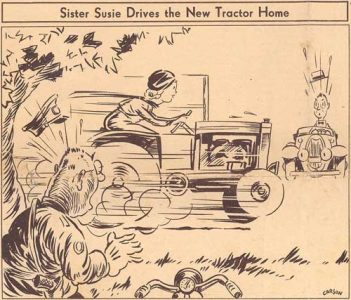During the late 1950s, the original brick farm house still stood on the Firestone Homestead farm east of nearby Columbiana, Ohio, before being moved to Greenfield Village near Detroit. During this time I was sent to the Firestone house to repair the telephone. I remember that hanging on the wall, just above the phone, was a framed photograph, taken during the 1930s, of a lineup of all of the farm’s machinery. The photo had been taken from a high spot, probably the barn roof or silo, and showed a Farmall F-20 or Regular tractor, along with the farm’s complete line of horse drawn and tractor implements, all shod with Firestone tires.
Harvey S. Firestone, 1868-1938, founded the giant tire company named after him and was an enthusiastic proponent of using pneumatic tires on farm tractors and machinery, which he tested on the Columbiana farm.
The first recorded attempt to use rubber tires was the English built “Thompson’s Rubber Tire Steamer” that was purported to “haul through soft ground, pull a gang of seven plows, and speed along the road at 10 miles per hour.” The machine was tested in California’s San Joaquin Valley in 1871, but was unsuccessful.
The second was in 1918, when the International Harvester Co. tried rubber on an 8-16 tractor. “The front wheels were fitted with solid-section rubber tires; the rear wheels with solid-section blocks moulded to metal detachable lugs and the blocks were made by the Firestone Tire & Rubber Co.” reported IHC’s engineer, L.B. Sperry. The off-road traction was unsatisfactory and the rubber block’s adhesion to the metal lug wasn’t good, so the attempt never got beyond the experimental stage.
The rural road net was being paved during the late 1920s and there was much opposition to steel lug wheels damaging the pavement. Many states passed laws prohibiting their use and farmers had to plank the roads to move their tractors on them or face fines. Detachable steel lugs or smooth steel overtires were sold but were cumbersome and time-consuming to use.
Industrial tractors had used solid rubber tires since the early 1920s but they provided little traction in grassy or muddy fields, Farmers and tractor builders began experimenting with truck and airplane tires and the B.F. Goodrich Co. got into the act. Early in 1931 BFG announced their “zero pressure” farm tractor tire. It was neither pneumatic nor solid, but had a web of solid piers inside that supported the outer arch which was said to give the tire enough flexibility to provide full soil contact and superior traction, besides being puncture proof. This tire must not have caught on, because in 1933 Goodrich was advertising a self-cleaning, low pressure tire using a tube.
In 1932, Allis-Chalmers engineers equipped a Model U tractor belonging to Wisconsin farmer Albert Schroeder with a pair of Firestone 48 X 12 airplane tires for a test that proved highly successful. A-C publicly tested an air tired tractor on Labor Day, 1932, and the test was a booming success. A-C announced in October that specially designed pneumatic tires, built by Firestone, would be standard equipment on Model U tractors.
There were many plowing and pulling matches staged to prove the superiority of rubber over steel and virtually all demonstrated that rubber air tires were better. Still, this was the depth of the Depression and farmers were a conservative lot, so acceptance was slow.
During the summer of 1933, Allis-Chalmers and Firestone sponsored tractor races at seven state fairs throughout the Midwest as well as at the Milwaukee Speedway. The best-known American automobile racing driver at that time, Barney Oldfield, drove a supposedly stock, except for high speed gears, Allis-Chalmers Model U at speeds of more than 40 MPH. One report says Barney set a world tractor speed record of 64.28 MPH on September 17th.
A publicity photo of Oldfield on tractor no. 999 shows Barney in white shirt and tie, leaning forward with one hand on the wheel and the other on the gear shift, ready to race. The Model U may have had a stock engine, but the wheels, with their white-lettered Firestone tires, are chrome and equipped with big chrome hub caps. The belt pulley face, exhaust and intake manifolds, carburetor and air intake all appear to be chromed, and the whole tractor glistens like a jewel.
All the tractors used on the fair circuit were provided by Allis-Chalmers and, except for Barney’s, were manned by A-C employees. Of course, Barney always won.
While these publicity stunts helped break down resistance to air tires, probably the most dramatic argument was Nebraska Tractor Test No. 223, begun in May, 1934. This was the first official test of a pneumatic tired tractor and was performed using an Allis-Chalmers WC. Dual tests were made using the same tractor, first equipped with air tires and then with steel wheels. 5.62 horsepower hours per gallon of fuel was recorded using steel wheels with the economy jumping to an amazing 8.18 on rubber tires. These economy results might be put into perspective by comparing them to the average horsepower hours per gallon of fuel attained by all 46 wheel-tractors tested during 1930, which was only 5.59.
The advantage of pneumatic tires over steel wheels in fuel economy and in rate of performance, not to mention driver comfort, caused the demand for rubber to rise quickly. 14 percent of wheel tractors were sold on rubber in 1935, 31 percent in 1936, 43 percent in 1937, 95 percent in 1940, and almost 100 percent by 1950.
The Allis-Chalmers engineers and Harvey Firestone truly made the modern farm tractor possible.
Illustration: A cartoon from the Spring, 1935 issue of The A-C News. [In the author’s collection]






